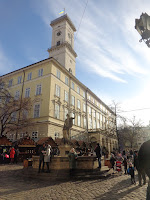When we left Kosice on New Year's Eve, we weren't in any rush to get to our next destination because we weren't sure how interested we would be in the midnight celebrations. So we made a detour to Bardejov, a UNESCO World Heritage site partially due to the medieval walls surrounding the city's original center (top left). One of the most effective and well-preserved parts of the fortifications, the Thick Bastion, has been converted from an ammunition storehouse into a community center (top right). But my favorite part was the main square, whose perimeter is formed by colorful burgher houses (bottom).
Crews next to the square's Town Hall were setting up for the evening festivities ahead; inspired, we decided to try to speed toward our potential party town for the night, Lviv. After a long slog on some slippery back roads and a short pass through a near-deserted border crossing, we arrived in the Ukrainian medieval town about 8 p.m. We settled Sage and our stuff into our hotel, then took a bus downtown, where we expected to have to fight partying masses in the streets. Much to our surprise, although there were crowds, plenty of seats were still available in restaurants, so we could score some food.After dinner, the sound of music lured us to the Opera and Ballet Theater, where Kurbasy was singing people into the holiday spirit (top left). Even though it was already about 11:30 p.m., we found plenty of standing room to witness the countdown. Apparently, unlike in the United States, the celebrations really start heating up not before but at midnight, when people pull out champagne and sparklers (top right). I was happy we had come to join the fun until fireworks started to be launched from what seemed like 10 feet away (bottom left). The locals were unfazed, but we evacuated to Pravda Beer Theater, where we toasted in 2018 with a few pints (bottom right).
About 2 a.m. we walked back to Hotel Pysanka, where an on-site party was still in full swing. After a long day, the bass from the banquet hall didn't bother us, so we got a good night's rest that allowed us to get an early start, including a traditional breakfast of syrniki, or cottage-cheese pancakes (top). Afterward, we stretched our and Sage's legs with a stroll through the old center, including past the peaceful Church of the Holy Communion (bottom left). With one last look at the lively Market Square, a UNESCO World Heritage site, we vowed to return then left for the long drive back home (bottom right).






























































